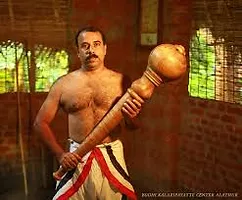Kalarippayatt
Kalarippayatt is the exclusive martial arts legacy of Kerala, which was taken to China by the Buddhist monks and became the legendary model for modern martial arts.
‘Kalari’ means gymnasium, and ‘payatt’ means combat. It is the most comprehensive personal combat training scheme in the world.
Kalarippayatt
Kalarippayatt is the exclusive martial arts legacy of Kerala, which was taken to China by the Buddhist monks and became the legendary model for modern martial arts.
‘Kalari’ means gymnasium, and ‘payatt’ means combat. It is the most comprehensive personal combat training scheme in the world.
Training includes exercises to develop sharp reflexes for unarmed combat and techniques of combat using mace, spears, daggers, sword/shield and the “Urumi”, a unique lethal flexible sword which can be concealed as a waist belt. Enhances physical consistency, strengthens the nerves and improves the appearance of the skin. Also for nervous disorders, rheumatism, osteoporosis, arthritis and malnutrition of limbs.
Training includes exercises to develop sharp reflexes for unarmed combat and techniques of combat using mace, spears, daggers, sword/shield and the “Urumi”, a unique lethal flexible sword which can be concealed as a waist belt. Enhances physical consistency, strengthens the nerves and improves the appearance of the skin. Also for nervous disorders, rheumatism, osteoporosis, arthritis and malnutrition of limbs.
Apart from being a martial art, Kalarippayatt includes:
- Marma treatment which identifies the vital nodal points (marmas) in the body (107 in all) for pressing and stroking to correct muscular and neurological problems.
- A massage that involves standing and applying pressure on the patient with the feet, known as Chavutti Thirummal.
- An invigorating Ayurvedic herbal treatment.
- Its own fracture treatment system developed to treat injuries that occur in the dynamic exercises and practices.
Apart from being a martial art, Kalarippayatt includes:
- Marma treatment which identifies the vital nodal points (marmas) in the body (107 in all) for pressing and stroking to correct muscular and neurological problems.
- A massage that involves standing and applying pressure on the patient with the feet, known as Chavutti Thirummal.
- An invigorating Ayurvedic herbal treatment.
- Its own fracture treatment system developed to treat injuries that occur in the dynamic exercises and practices.
All Kalari practitioners frequently undergo a series of treatments to strengthen their bodies and prepare them for combat.
The growth and development of several forms of theatre and dance in Kerala has been highly influenced by the Kalari system. Kathakali dance, well known in the West, is a typical example.
All Kalari practitioners frequently undergo a series of treatments to strengthen their bodies and prepare them for combat.
The growth and development of several forms of theatre and dance in Kerala has been highly influenced by the Kalari system. Kathakali dance, well known in the West, is a typical example.
The term Kalari applies to the centers of training for both a warrior and an artist. Literally, it is a learning center of letters and physical culture. Thus the institution of Kalari has become an inseparable part of the cultural heritage of Kerala.
Kalaripayatt is an orthopedic system, massage regimen, ayurveda treatment and cultural experience – all rolled into one. Experience this art form under palm-leaf thatched Kalari huts.
The term Kalari applies to the centers of training for both a warrior and an artist. Literally, it is a learning center of letters and physical culture. Thus the institution of Kalari has become an inseparable part of the cultural heritage of Kerala.
Kalaripayatt is an orthopedic system, massage regimen, ayurveda treatment and cultural experience – all rolled into one. Experience this art form under palm-leaf thatched Kalari huts.
Location:
A well dug Kalari built strictly according to norms in Vadakara, North Kerala (near Kozhikode).
Possibilities for sightseeing:
Turtle hatchery, Kappad beach, Small island near Vadakara, Peruvannamoozhi (hill resort), Old forts (including famous Thalassery fort), Waynad (hill resort, plantations), Temples.
Outline:
Kalarippayatt consists of four parts. Of these, the first part is the most significant and fundamental. The course of 30 days covers all sections in this part. Needless to say, rigorous practice is essential. Condensed course of 14 days also possible.
Two sessions in a day:
5.30 to 7.30 a.m – Teaching, learning and activity
6.00 to 9.00 p.m – Practice
Dates:
No specific dates. Just let us know one month in advance.
Content:
Alighting in the Kalari
Introduction
Kacha-kettu
(Tying a long loin cloth which binds and supports the groin)
Rubbing oilGuru-vanakkam (Teacher salutation)
Easwara-vanakkam (God salutation)Naga-vanakkam (Snake salutation)
Dik-vanakkam (Direction salutation)Aayudha-vanakkam (Weapon salutation)
Surya-chandra-vanakkam (Sun & Moon salutation)Mei-adavu (Clever body movement) – 1, 2 & 3
Mei-payatt (Combat steps) – 1
Mei-adavu – 4, 5 & 6Vadivus (Special postures)
Rest day
Vadivus contd.
Mei-adavu – 7, 8 & 9
Mei-payattu – 2Chuvadus (Forms of movement)
Mei-payatt – 3 & 4Mei-payatt – 5
Mei-payatt – 6
Examination
Kaaluyarthi-payatt (Raised leg combat) – 1
Mei-adavu – 10, 11 & 12Kaaluyarthi-payatt – 2
Mei-adavu – 13, 14 & 15Cleaning the bowels
Mei-othukkam-payatt (Supple body combat)
Mei-adavu – 16, 17 & 18Kaaluyarthi-payatt – 3
Kaaluyarthi-payatt – 4
Kaaluyarthi-payatt – 5
Kaaluyarthi-payatt – 6
Examination
Stick fighting – 1 (Long cane)
Stick fighting – 2 (Other kinds)
Practice on a beach
Review and correction of mistakes
Some special techniques
Final examination and practice in a group
Rehearsal of the whole course
Farewell









